The Coming Wave
Finance & Development, June 2013, Vol. 50, No. 2
G. Andrew Karolyi, David T. Ng, and Eswar S. Prasad
Private investors from emerging market economies increasingly put their funds in overseas assets
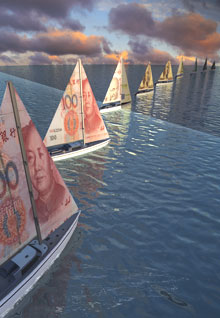
As emerging market economies become increasingly important players in the global economy, their share of the global cross-border flows of financial assets is also rising. Because of their strong growth prospects, emerging market economies have attracted foreign investors in search of higher returns, especially at a time of very low interest rates in advanced economies. And flows have also gone in the other direction, as the governments of emerging market economies have built up their foreign exchange reserves by investing heavily in advanced economies.
Recently, another phenomenon has gradually gained momentum: the outflow of private capital from emerging market economies as their investors seek overseas opportunities.
Understanding the volumes and patterns of the various outflows—sovereign and private—and analyzing what influences them will shed light on how the landscape of international capital flows is likely to change as emerging market economies become more integrated into global financial markets. We look at the types of capital outflows from emerging markets and describe some preliminary results from our ongoing research, which shows that the direction of portfolio outflows—relatively small now, but with a large potential to expand—is heavily influenced by proximity and familiarity.
Exporting capital
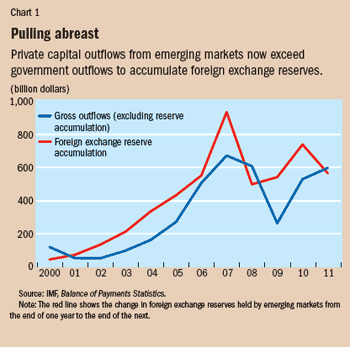
Led by China, emerging markets added about $6 trillion to their foreign exchange reserves between 2000 and 2012—with nearly all of it invested in securities issued by the major reserve currency economies, mainly the United States. It is likely that these emerging market economies will accumulate foreign exchange reserves at a much slower pace in coming years because most have put away sufficient stocks of foreign reserves to help buffer any future capital flow volatility.
As reserve accumulation subsides, we anticipate a rapid expansion of private capital outflows from these economies. In fact, such outflows are now matching the increase in official reserve accumulation (see Chart 1). China is, of course, an important driver of these private flows as well, and when China is removed from the picture, the overall numbers are less impressive. But for the emerging markets excluding China, private capital outflows are now greater than those that represent reserve accumulation (see Chart 2).
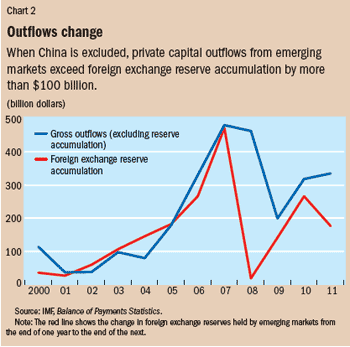
There are many reasons to expect private outflows to increase. As households in emerging market economies become richer and achieve higher levels of savings, they will seek opportunities abroad to diversify their portfolios. Institutional investors, such as mutual funds and pension funds, are already becoming important conduits for these outflows. Corporations and financial institutions are also likely to continue to seek foreign investment opportunities as they expand their operational bases internationally and reach into foreign markets.
China shifts
Changes in the structure of capital flows in China, the world’s second-largest economy, provide a good illustration of these trends. China has been a big net exporter of capital to the rest of the globe for the past decade. It has run a trade surplus, exporting more goods and services than it imports, as well as a capital account surplus, which reflects inflows of private capital. During this period, China has run an overall surplus on its current account, indicating that China is, on net, exporting capital to the rest of the world. These capital exports have largely taken the form of foreign exchange reserve accumulation by the People’s Bank of China, its central bank; the reserves are managed by its State Administration of Foreign Exchange (SAFE). This accumulation is the result of foreign exchange market intervention by the central bank, which buys dollars to limit the appreciation of the Chinese currency (the renminbi) to avoid any loss in China’s export competitiveness. China invests a significant proportion of those dollars in foreign securities, such as U.S. Treasury bills and bonds. China’s official holdings of U.S. Treasury securities were $1.26 trillion as of January 2013, according to data from the U.S. Treasury.
Given the pressures on its currency and worries that capital inflows could fuel inflation and sharp increases in asset prices, China has been cautious about letting in foreign capital. Foreign investors are restricted from investing extensively in China’s equity market, although some channels have been opened up—such as the greatly expanded quotas of the Qualified Foreign Institutional Investor (QFII) scheme. Chinese bond markets remain relatively underdeveloped. Consequently, most of the inflows to China have been in the form of foreign direct investment (FDI), which generally involves acquiring a controlling interest in a business. Gross FDI inflows into China averaged $260 billion a year during 2010–12, according to IMF data. (These figures are consistent with data from SAFE, but China’s Ministry of Commerce indicates inflows of only $110 billion a year during that period.)
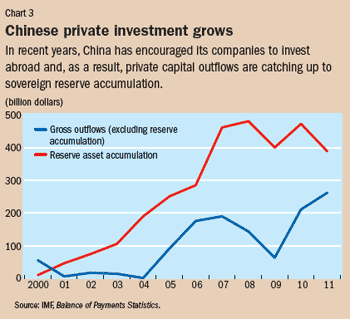
More interestingly, though, private capital outflows from China have increased significantly in recent years. China had maintained tight controls on outflows but has relaxed them over time. From 2004 to 2012, FDI outflows from China went from essentially zero to more than $100 billion according to IMF data. (Data from SAFE show lower outflows of $62 billion in 2012; the Ministry of Commerce does not report data on outflows.)
In fact, China has been encouraging not only its corporations but also institutional investors—such as mutual funds and pension companies—to invest abroad. In 2006, it even set up the Qualified Domestic Institutional Investor scheme, a parallel to its QFII program, to sanction investments abroad up to specified limits. As a result of such measures, other forms of outflows have been rapidly catching up to official outflows for currency reserves (see Chart 3). Preliminary data for 2012 show that reserve accumulation fell sharply even as other outflows continued to increase, a trend that is likely to continue.
These developments have raised concerns that rising capital outflows reflect worries among domestic investors about China’s growth prospects. In reality, these outflows may simply reflect a maturing economy that is allowing capital to flow out (and in) more freely. As China becomes a richer economy and as its financial markets become more developed, providing more opportunities for investors to diversify their portfolios, private outflows are likely to increase further. Other emerging markets are likely to follow a similar path.
Changing composition of outflows
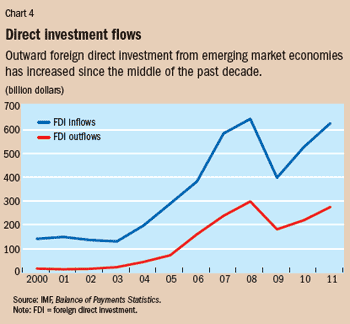
The composition of private outflows from an emerging market economy is determined by capital controls imposed by government authorities and the level of financial market development. Fears that surges in outflows could destabilize domestic financial systems have led many of these economies to restrict private outflows. Still, some have become increasingly willing to allow their corporations to invest abroad. Mergers and acquisitions by emerging market economies have increased sharply in recent years. Sometimes they involve a firm in one emerging market economy buying a firm in another emerging market; sometimes an entity in an emerging market economy acquires a firm in an advanced economy. There are many potential drivers of this activity, including the desire of emerging market firms to diversify their production bases and increase their penetration of other markets. Purchases of foreign firms can also help them acquire technology that domestic firms can then use to upgrade their production capabilities. There has been a noteworthy increase in FDI outflows from these economies since the middle of the past decade (see Chart 4).
Limited financial market development in emerging market economies is an important constraint on outward portfolio investments by households. China and India, for example, now allow individuals to take a large amount of wealth abroad each year ($50,000 in the case of China; $200,000 in the case of India). However, financial markets in these countries are underdeveloped, so most households do not have easy access to such investment vehicles as mutual funds that would allow them to buy foreign equities or bonds. The rapid development of financial markets in these countries—along with the growing prominence of institutional investors, such as pension funds, insurance companies, and even mutual funds—is likely to create more channels for portfolio outflows.
Why should investors in emerging markets want to invest abroad when their economies are growing much faster than those of the advanced economies? In theory, international investments offer retail investors in emerging market economies an opportunity to diversify the risk in their portfolios. Moreover, in some of these countries, financial systems are still dominated by banks, which traditionally pay relatively low interest rates on savings deposits (especially after inflation is taken into account). Stock markets in some emerging economies are still relatively small, less liquid than those in advanced economies, and valuations are often highly volatile. All of these factors drive institutional investors, such as pension funds, mutual funds, and insurance companies, to invest abroad—and influence portfolio equity flows.
Portfolio equity flows
Because of their strong growth potential and the rapid opening up of their equity markets to international investors, emerging market economies have become important destinations for global portfolio equity flows (including from other emerging markets). For instance, in 2000, emerging market economies accounted for 3 percent of the global stock of foreign portfolio equity investments. By 2010, that share had risen to 16 percent. Consequently, there is a burgeoning academic literature that looks at patterns and determinants of foreign investment flows into emerging market countries. Far less attention has been paid to a more modest but growing phenomenon: investment in foreign securities by emerging market investors.
One indicator of the relative importance of emerging markets in international finance is their share in global external portfolio equity assets—this share rose from 1 percent in 2000 to 5 percent in 2010. In absolute amounts, this reflects an increase in the external portfolio equity assets of emerging market investors from $67 billion to $643 billion. Inflows from emerging markets are playing an increasingly important role in external portfolio liabilities of even major advanced economies. Consider, for instance, the relative importance of emerging markets in foreign portfolio investments into the United States. The share of foreign holdings of U.S. equities accounted for by emerging market investors rose from 2 percent in 2002 to 7 percent in 2011, according to data from the IMF’s Coordinated Portfolio Investment Survey. Data from the U.S. Treasury paint a similar picture.
These data suggest an increasingly prominent role for emerging markets in cross-border portfolio flows, a phenomenon that is likely to intensify as emerging markets grow richer, open their capital accounts, and develop their financial markets. How much foreign investment outflow is likely to emanate from emerging markets? Finance theory provides one way of thinking about the optimal level of foreign investment: To maximize diversification benefits and obtain a superior risk-return trade-off, rather than investing just in their domestic stock market, investors should, in principle, hold a broadly diversified international portfolio in which the weights are based on the market capitalization of each relevant country’s stock market. Given that emerging markets still constitute only 8 percent of the world’s market capitalization, their investors should, in principle, hold a significantly larger share of their investments in advanced economy stock markets.
In reality, investors do not diversify anywhere close to the extent suggested by standard models. Investors in virtually every country, including those with open capital accounts and sophisticated financial markets, tend to exhibit a high degree of home bias (investing disproportionately in domestic stock markets). Explanations for home bias include information asymmetries (investors know more about domestic stocks than foreign ones), trading costs, and financial market underdevelopment. Given the enormous increase in cross-border equity flows over the past decade and the attenuation of barriers such as information asymmetries and trading costs, home bias is expected to decline. Studies indicate, however, that the bias has not abated much over the past decade.
Nevertheless, as global financial markets become more integrated and informational barriers shrink, other related biases could be affected by expanding portfolio diversification. For example, nondomestic portfolio allocations have been shown to be subject to a regional foreign bias (disproportionately large investments in stock markets of neighboring countries). Investors also place funds disproportionately in countries with which their nation trades heavily, or countries with which they are familiar because of colonial heritage or similar languages. Other factors, such as political stability, could also influence these decisions. Theory does not provide strong guidance about how some of these variables should drive portfolio allocations. For instance, a country with poor governance should be less attractive to international investors, but similarities in corporate governance between host and recipient countries could, in fact, increase bilateral flows due to a “familiarity” effect. Theory also fails to guide us on whether and how these foreign biases would disappear with expanded capital flows. These issues must be resolved through empirical analysis.
Focusing on actions of institutional investors
We examined total outward portfolio equity investment from emerging markets and then analyzed in more detail outflows mediated through mutual funds and other institutional investors. Our analysis is based on a broad empirical exercise covering the period from 2000 to 2011 and uses standard portfolio theory to guide our interpretation of the results; we do not test a specific theoretical model of portfolio allocations.
We use two data sets in our analysis. The first one is based on the IMF’s Coordinated Portfolio Investment Survey, which contains bilateral cross-border portfolio equity holdings (stocks rather than flows). We also use a database of individual institutional investors in both advanced and emerging market economies to provide more disaggregated evidence on what drives cross-border portfolio equity flows.
In our preliminary research, one interesting conclusion is that “gravity” variables (so called because they contain elements of mass and distance to mimic the gravitational interactions in Newtonian physics)—which capture “closeness” or “proximity” in terms of geographic distance, common language, colonial heritage, and common free trade zone—are important determinants of cross-border portfolio equity flows. The importance of these factors has already been established in the literature looking at investors in advanced economies; we find that emerging market investors seem to base their foreign investments on similar considerations. One possibility is that these variables, which have been found to play an important role in influencing patterns of cross-border trade flows, are simply capturing the fact that financial flows are linked to trade flows. However, we find that the importance of gravity variables in explaining bilateral portfolio equity flows is unaffected when we directly control for bilateral trade relationships. One implication of our preliminary results is that portfolio outflows from emerging markets are going to lead to greater regional financial integration, at least in the initial phases of the expansion of these outflows.
Rising outward flows
One important, but little-studied, aspect of the growing prominence of emerging market economies is outward investment flows from these economies. While these outflows are still relatively modest, they are increasing at a rapid rate. As these economies become richer, develop their financial markets, and liberalize cross-border capital flows, retail and institutional investors from these economies will increasingly seek investment opportunities abroad for diversification purposes. Preliminary evidence suggests that investors in these economies seem to display home and foreign biases related to geographic proximity and familiarity similar to those of advanced economy investors. This could impel greater regional integration of financial markets and generate increasing portfolio equity flows among emerging markets themselves. ■
Andrew Karolyi is a professor at the Johnson School of Management, Cornell University. David Ng and Eswar S. Prasad are an associate professor and professor, respectively, at the Dyson School of Applied Economics and Management, Cornell University. Ng was a visiting fellow at the Hong Kong Institute for Monetary Research. Prasad is also a senior fellow at the Brookings Institution.


